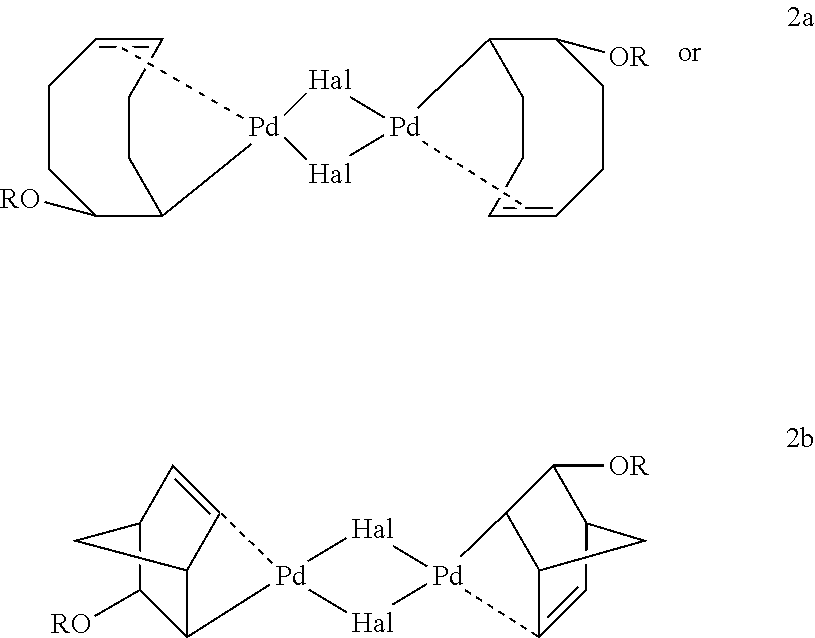Preparation of a metal complex
- Summary
- Abstract
- Description
- Claims
- Application Information
AI Technical Summary
Benefits of technology
Problems solved by technology
Method used
Image
Examples
example 1
Synthesis of Di-μ-bromo[(1,4,5-η)-8-methoxy-4-cycloocten-1-yl]dipalladium,9Br
[0105]
[0106]A solution of NaOH in 1 mL methanol (1.5 mmol, 0.06 g) was added to Pd(COD)Br2 (1.3 mmol, 0.5 g) suspended in 2 mL toluene at 0° C. The resulting mixture was stirred for 15 minutes at 0° C. and filtered. The filtrate was evaporated under vacuum, washed with 1 mL cold methanol and dried under high vacuum to obtain the title product in 92% yield (off-white solid, 0.4 g). 1H NMR (C6D6,): δ (ppm) 5.83 (m, 2H), 5.64 (m, 2H), 4.11 (b,2H), 3.63 (m, 2H), 3.12 (s, 6H), 1.40-2.20 (m,16H). 13C NMR (C6D6): δ (ppm) 107.9, 102.9, 81.6, 56.2, 53.4, 34.8, 31.1, 27.9, 26.5. Elemental analysis: C18H30Pd2Br2O2; Calcd.: C, 33.21, H, 4.64; Found C, 33.08, H, 4.58.
[0107]The X-ray crystallographic structure of the title compound is given in FIG. 1. Thermal ellipsoids are shown at 50% probability (hydrogen atoms were omitted for clarity). Selected bond distances (Å) and angles (deg): C1-C2, 1.373(9); C5-C6, 1.512(9); P...
example 2
Synthesis of (Cy3P)2Pd(H)Br
[0109]
[0110]A solution of NaOH in methanol (2.7 mmol, 0.11 g, 1.5 mL MeOH) was added to Pd(COD)Br2 (2.7 mmol, 1 g) suspended in 3.5 mL toluene at 0° C. The resulting solution was then reacted with tricyclohexylphosphine (Cy3P) (5.4 mmol, 1.4 g) in 10 mL toluene under N2 at 0° C. for 2 h. To this solution, 20 mL methanol was added to precipitate the product, which was subsequently filtered, washed with methanol (3×10 mL) and dried under high vacuum to obtain 1.7 g product as white solid in 85% yield. 1H NMR (C6D6): δ (ppm) 2.39 (t, 6H), 2.24 (d, 12H), 1.83 (m, 30H), 1.38 (m, 18H), −13.06 (1H). 31P NMR (C6D6): δ (ppm) 41.9 (s). Elemental analysis: C36H67BrP2Pd; Calcd.: C, 57.79; H, 9.03; Br, 10.68; Found C, 57.83; H, 8.91; Br,10.32.
[0111]The X-ray crystallographic structure of the title compound is given in FIG. 2. Thermal ellipsoids are shown at 50% probability (hydrogen atoms were omitted for clarity.) Selected bond distances (Å) and angles (deg): Pd—Br, 2...
example 3
Isolation of methoxy-cyclooctadiene
[0112]The filtrate from the above the procedure to synthesize (Cy3P)2Pd(H)Br was evaporated to dryness and the residue was extracted with 20 mL pentane. The solvent was evaporated and the product dried under high vacuum to afford the title product in 81% yield (yellow oil, 0.3 g).
[0113]This oil was found to be a mixture of two structural isomers: 1-methoxy-1,5- cyclooctadiene and 6-methoxy-1,4-cyclooctadiene with a ratio of 76:24 by NMR. 1H NMR (C6D6): 1-methoxy-1,5-cyclooctadiene δ (ppm) 5.69 (m, 2H), 4.60 (t, 1H), 3.35 (s, 3H), 1.2-2.6 (m, 8H). 6-methoxy-1,4- cyclooctadiene 1H NMR (C6D6): δ (ppm) 6.06 (b, 1H), 5.85 (b, 1H), 5.60-5.70 (m, 2H), 4.03 (m, 1H), 3.24 (s, 3H), 1.2-2.37 (m, 6H). Elemental analysis: C9H14O; Calcd.: C, 78.21; H, 10.21. Found: C, 78.05, H, 10.09. GC-MS: m / z=138.3
Pd(0)L2 Complexes
PUM
 Login to View More
Login to View More Abstract
Description
Claims
Application Information
 Login to View More
Login to View More - R&D
- Intellectual Property
- Life Sciences
- Materials
- Tech Scout
- Unparalleled Data Quality
- Higher Quality Content
- 60% Fewer Hallucinations
Browse by: Latest US Patents, China's latest patents, Technical Efficacy Thesaurus, Application Domain, Technology Topic, Popular Technical Reports.
© 2025 PatSnap. All rights reserved.Legal|Privacy policy|Modern Slavery Act Transparency Statement|Sitemap|About US| Contact US: help@patsnap.com



